Review of Teaching & Learning in Social Work for 2019

It is that time of year again – the annual review of the Teaching & Learning in Social Work Blog. This will be my fourth year reflecting on the work of this blog; the first end of the year post was in 2016. This year, I am thinking more about my motivation for starting and maintaining this blog for the past seven years. As I think back on why I started Teaching & Learning in Social Work, I’d have to say I wanted to be a more confident writer. Academic writing is not easy. This blog helped me to find my academic voice while allowing me to experiment with writing. I try to be personable in the posts I write, using plain language and concise phrasing. While I can say I am more comfortable with my professional writing, the greatest benefit to this blog is having space to share my work and the work of others in a very non-traditional space. Publishing is a peer-reviewed journal is currency for academics, and it is a narrow, rigid, and polished way to share one’s work. By writing blog posts about my work early in the process, I can share with a wider audience including students, social work practitioners and professionals from other fields. I can also as publish work that may never find a home as a journal article, but is still of value to others. For example, I write frequently about my assignments and classroom activities on this blog. I also post information about my conference presentations here so others can easily reference the materials. Overall, I can say with confidence that writing and publishing Teaching & Learning in Social Work has truly be beneficial and motivating for my academic writing.
For 2019, I had three goals for improving the blog:
Reflections from the Summer 2019 Institute on Pedagogy and Technology for Online Courses
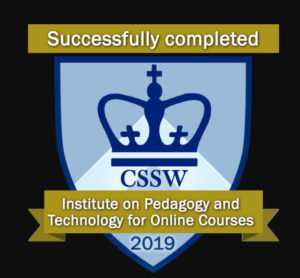
Growing up, I loved summertime! I have some fond memories of traveling, riding my bike, swimming, and general goofing off. Now, this past summer I worked….okay, there was a little swimming and a lot of traveling, and I took an online course. Not just any course; I am a proud graduate of the Columbia School of Social Work’s Institute on Pedagogy and Technology for Online Courses. In what has to be the most tardy “what I did over the summer” essay ever, I want to share why I took this course and more importantly, my key takeaways from this experience.
The Institute has been around since 2017 and consists of five weeks of modules with a two-hour live session and homework each week. While it is geared toward training instructors for Columbia’s Online Social Work Program, anyone can apply for the Institute, and completing the training doesn’t obligate one to teach for Columbia’s Online Social Work Program. The Institute models what a typical online course is like at Columbia, and incorporates many best practices for how to teach an online course. In fact, the Institute has won awards from the International E-Learning Association and United States Distance Learning Association. To learn more about the Institute I recommend the following articles:
#APM19 – Changing Teaching Practices for Technology: Using the SAMR Model for Technology Integration
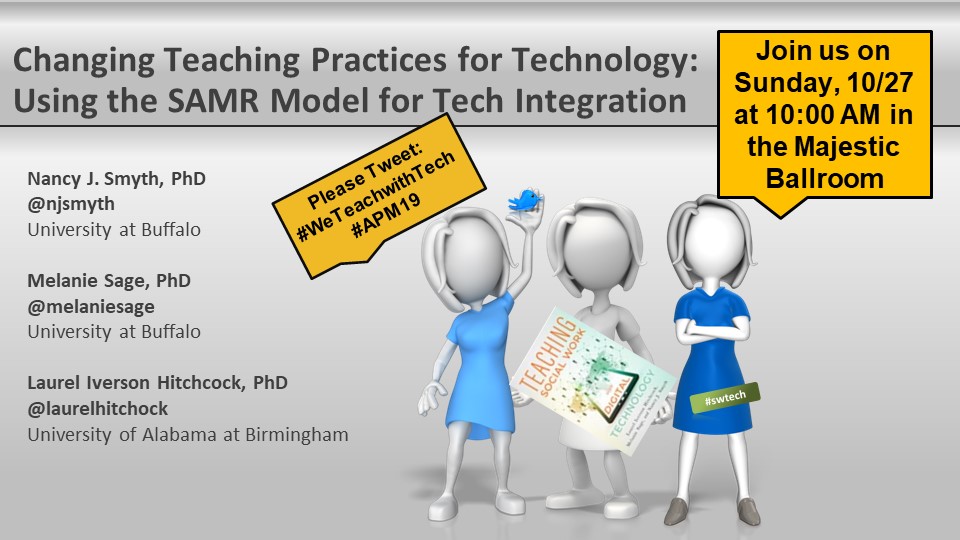
On October 27, 2019 at 10:00 AM, during the Annual Program Meeting for the Council on Social Work Education in Denver CO, Melanie Sage and I will be sharing some insights from Chapter 4 of our book, Teaching Social Work with Digital Technology, co-written with Nancy Smyth. If you are still in Denver, please come find us in the Majestic Ballroom –Tower Building of the conference hotel. We will be sharing how Puentedura’s SAMR Model for Technology Integration can be used to incorporate technology into traditional social justice assignments in social work education. There will also be time to adopt one of your current assignments using the SMAR Model.
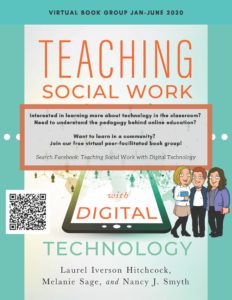
Additionally, we’ll be talking about our virtual book group that will be launch in January 2020. You can read more about it here:
For those of you who cannot make the presentation, we are including the details in this blog post.
Teaching Social Work with Digital Technology Book Group
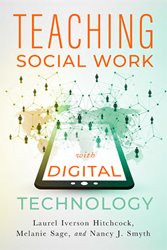
If you teach social work with technology, either online or in a traditional classroom, we (Melanie, Nancy and Laurel) invite you to learn with and from peers in this free book group – Teaching Social Work with Digital Technology. Goals of this virtual book group are to: 1) create a supportive learning community; and 2) provide space for reflection about one’s own professional development with teaching with technology.
This group will run from January to June 2020, with monthly meetings and a moderated online private Facebook group. The group will include live virtual meetings, with discussion moderated by an author and a guest educator. In between meetings, social work educators will lead and moderate book discussions, and offer reflective questions and simple learning tasks. Participants should have access to the book by January 2020. The schedule follows:
Three Ways to Model Good Boundaries with Technology in Social Work Ed

The National Association of Social Workers’ (NASW) Standards for Technology in Social Work Practice (2017) offer a number of standards for social work educators and practitioners. One of these standards focuses on maintaining boundaries with our students. This is not a new ethical practice for social work educators; we have always worked to maintain boundaries with our students. Rather, the challenge has been navigating these boundaries in virtual spaces as technology has changed when and how we can communicate and engage with each other.
Not surprisingly, the tech standard from NASW focuses on the social work educator taking precautions. Managing risk is a good idea, and I would suggest that we also embrace the affordances that digital and social technologies can offer our students, our classrooms and our own professional development. The big question for most of us is how to do this in ways that are comfortable, manageable, and ethical. Over the past few years, many social work educators have contributed their knowledge and expertise to this blog about how they engage students around technology in their classrooms. In this post, I have pulled together some of their suggestions for how you can model good boundaries with technology in your teaching practice.
Tips for New Online Social Work Educators
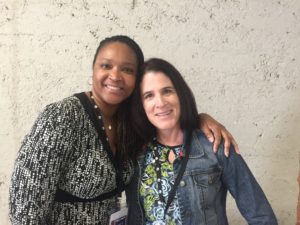
Editor’s Note: Melissa Thompson, MSW is a lecturer at Dominican University in Chicago, IL, and tweets at @mmt98. Nathalie P. Jones, PhD, MSW is an Associate Professor of Social Work at Tarleton State University and tweets at @Dr.NJones. In this blog post, they share their best tips for social work educator who are new to online teaching.
According to the National Association of Social Workers’ (NASW) Technology Standards for Social Work Practice (2017), social workers are urged to use technology in an ethical manner for practice and learning environments. In higher education, we hear about “digital native” students, who have grown up with a life centered on technology and who present as digital super humans. However, research is increasingly showing this concept to be a myth, and that designed learning environments focused on this myth can lead to poor learning outcomes (Kirschner & De Bruyckere, 2017). Another myth we often see among social work educators is the perception that non-traditional students are resistant to the use of technology in the classroom. Recent data from the Council on Social Work Education’s (CSWE) National Workforce Data Brief (2018) shows this to be a myth as well, reporting that when it comes to online education in social work, the highest enrollment rates were non-traditional students.


